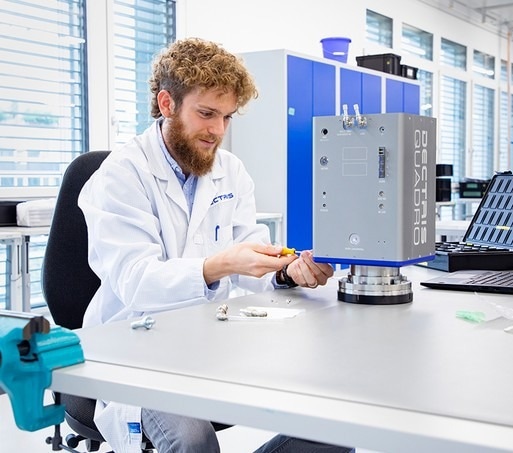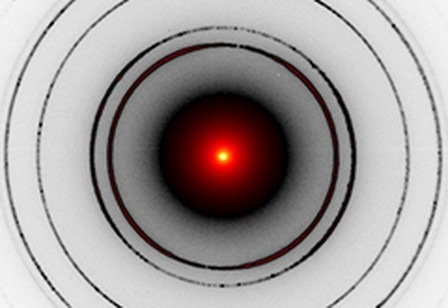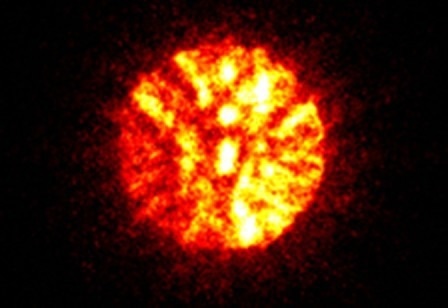QUADRO is a hybrid-pixel, radiation-hard electron detector from DECTRIS that enables users to concentrate on their sample rather than the camera.
QUADRO is the first direct electron detector to be launched by DECTRIS. It is based on hybrid-pixel technology and is fitted with DECTRIS’ signature instant retrigger, noise-free acquisition, and continuous readout.
The DECTRIS QUADRO detector can count every single electron even at a high count rate (up to 10 million el/s/pix), and guarantees a more precise data collection.
Owing to QUADRO’s remarkably high dynamic range, the experimental setup will not require a beam stopper. This will allow users to acquire continuous diffraction patterns.
This feature, along with the sensitivity and speed of the QUADRO detector, transforms methods such as electron imaging, strain imaging, micro-electron diffraction (microED), and ptychography.
- Efficient: QUADRO detector’s rapid readout chip, integrated with its silicon sensor material, offers suitable Detective Quantum Efficiency (DQE), even if energies are low.
- Easy: The QUADRO detector matches well with SerialEM. Its application programming interface (API) allows direct integration into any microscopy application platform.
- Radiation-hard: The QUADRO detector does not need a beam stopper. This will enable users to gather all data without intrusion.
Detector Specifications
Source: Dectris Ltd
| . |
. |
| Number of pixels (W x H) |
512 x 512 |
| Active area (W x H) [mm²] |
38.4 x 38.4 |
| Pixel size (W x H) [µm²] |
75 x 75 |
| Sensor material |
Silicon (Si) |
| Energy range [keV] |
30 - 200 |
| Frame rate (max.) [Hz] |
2,250 (16-bit); 4,500 (8-bit) |
| Frame rate (ROI, max.) [Hz] |
9,000 (16-bit); 18,000 (8-bit) |
| Count rate (max.) [el/s/pixel] |
107 |
| Detective Quantum Efficiency, DQE(0) |
0.9 at 100 kV, 0.8 at 200 kV |
| Detector mounting |
Bottom-mounted, on-axis |
*All specifications are subject to change without notice.
Integrated Solutions
The DECTRIS QUADRO detector can be incorporated into electron microscopy instruments.
ELDICO Scientific Electron Diffractometer

This exclusive electron diffractometer allows crystallographers to unravel vital structural data faster, and with superior quality economically.
NanoMegas’ TopSPIN Strain Applications

TopSPIN Strain integrates Precession Electron Diffraction (PED) with automated strain mapping and examination of diffraction patterns by comparing strained and unstrained regions of the same crystalline sample.
TESCAN TENSOR 4D STEM

TENSOR is a recently introduced, completely integrated, precession-aided, analytical STEM. Its core capability is scanning diffraction imaging, which is improved—among other features—by the sensitivity and speed of a hybrid-pixel direct electron detector, DECTRIS QUADRO.
Case Study

Image Credit: Dectris Ltd
In his study, Dr. Tim Gruene examined the scenarios of electron diffraction for fast identification of structures using a hybrid-pixel electron detector.
Publication: Rapid Structure Determination of Microcrystalline Molecular Compounds Using Electron Diffraction, Angewandte Chemie, October 2018.
Techniques
Micro-Electron Diffraction (microED)

Image Credit: Dectris Ltd
Users can obtain superior-quality microED data quickly using direct electron detection, integrated with the radiation hardness and the high dynamic range of electron detectors from DECTRIS.
Four-Dimensional Scanning Transmission Electron Microscopy (4D STEM)

Image Credit: Dectris Ltd
Users can gather 4D STEM data of the maximum possible quality with precise and dependable electron-counting detectors from DECTRIS.